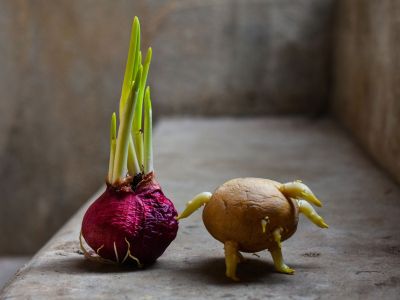Gardening from scraps has gained a lot of popularity, and it’s a great tool for teaching children about the growth process. Creating a kitchen scrap garden will also help you teach lessons related to food waste, organic growing, and sustainability.
What is a Kitchen Scrap Garden?
Sometimes referred to as a “quickie vegetable garden,” gardening with things from your kitchen is an easy way to grow produce parts that would usually be discarded, meaning that new vegetable plants are grown from items that would otherwise be headed toward the compost pile. This includes things like tomato seeds, sprouted potatoes, or even the rooted end of celery stalks. Many kitchen scrap gardens may not even require any soil. Some greens, such as lettuce, can be regrown in water to produce new green growth. Simply fill a shallow dish with water just so that the root end of the plant is covered. Then, move the plant to a bright windowsill. As the plant begins to grow from the roots, you will need to change the water to keep it clean and fresh. While it is possible to regrow some plants using only water, others may have more success by planting directly into container soil. Crops such as garlic and various herb plants can be placed in soil outside and allowed to grow into full sized productive plants. Root vegetables like potatoes and sweet potatoes may also be planted and grown from tubers that have reached their expiration date in the kitchen.
Quickie Vegetable Garden for Kids
When creating a garden from kitchen scraps, the options are limitless. However, it’s important to remain realistic. Treatments in commercial produce, such as the use of growth inhibitors, may cause failure of plants to sprout or grow. For the best attempt at growing a kitchen scrap garden, choose only produce labeled as non-GMO and organic. Better yet, grow them with leftover veggies from your garden instead. Growing kitchen scraps offers a fast alternative to seed sown veggies, as most of them sprout new growth rather quickly. In fact, this is a great project to try at home while you are waiting for previously sown seeds to germinate. Gardening with food scraps from your kitchen will teach your kids not only where food comes from and its healthfulness, but they will learn about sustainability practices, not being wasteful and reusing items whenever possible.
